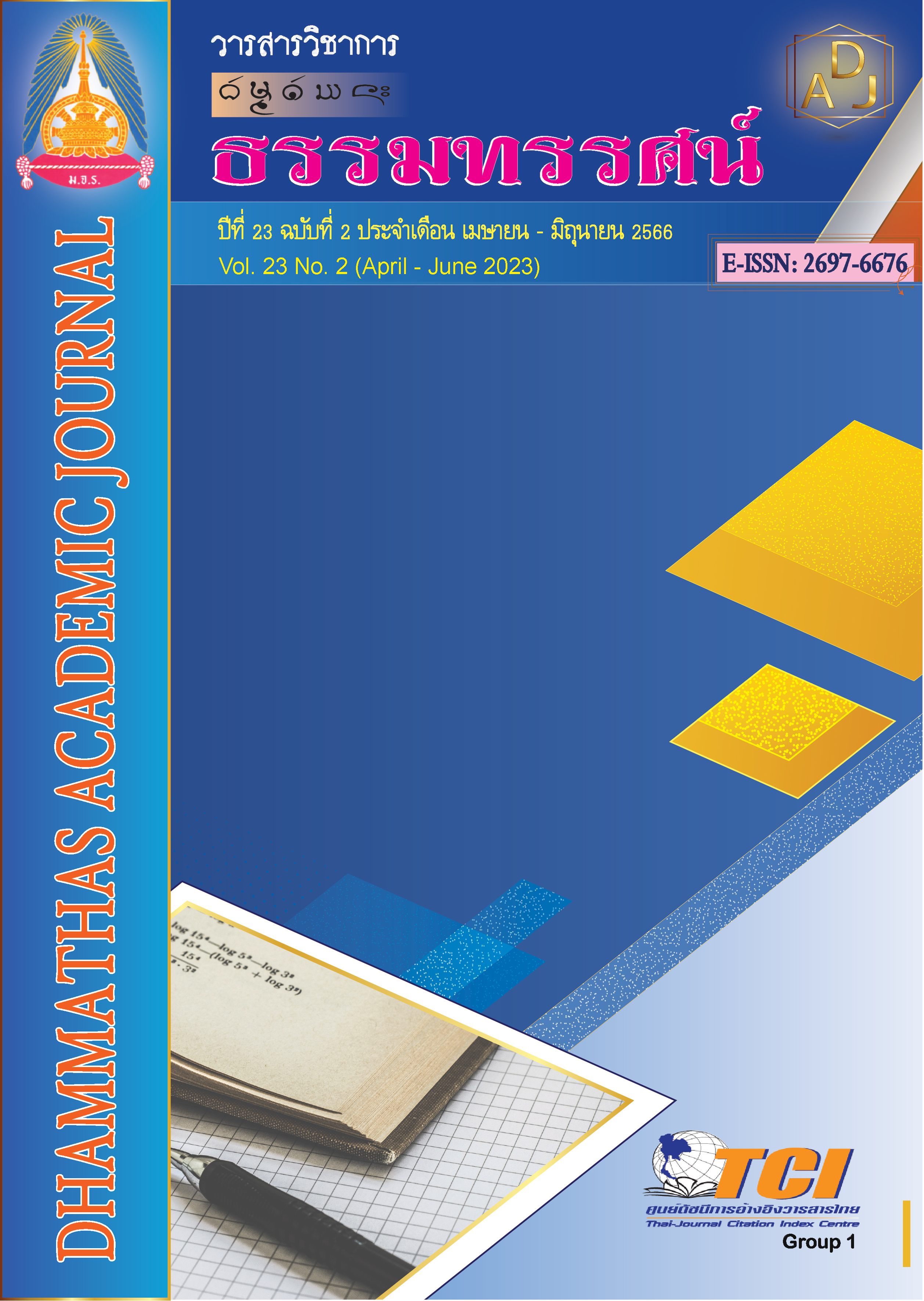The Development of Curriculum Enhancing Basic Moral for Students Lower Secondary School of Pariyattitham School in Ubonratchatani Province under the National Office of Buddhism
Main Article Content
Abstract
This Research was the objectives: 1) to study the current situation and the problems in the development of Enhancing Curriculum basic morality, 2) to construct the Enhancing Curriculum basic morality, 3) to study the experimental results the Enhancing Curriculum basic morality, 4) to study the satisfaction of students towards the Enhancing Curriculum basic morality. The research takes the research and development model, with 4 phases: Phase 1: Study of current conditions, problems, 3 methods: (1) Inquire about the current situation, problems (2) Interviews with experts, (3) Study visits in schools with the concept good practices in education management to enhancing basic morals. Phase 2: The
curriculum creation and instruction manual of Curriculum. Phase 3: Experimental use of the enhancing curriculum basic morality. Phase 4: Assessment of student satisfaction with the Enhancing Curriculum basic morality. The statistics used in the research were basic statistics: Percentage, Mean, Standard Deviation, and t-test for dependent sample
statistics.
The results was the research as follows:
1. At present, the development of the basic morality optional curriculum was at a high level and Moderate problem.
2. The basic morality optional curriculum were consists of 6 elements, namely: principles, learning outcomes, the structure of unit learning, media, and learning
resources; measurement and evaluation. Course quality and course manual have the overall appropriateness at the highest level.
3. The experimental results of the Basic Moral optional Curriculum found that, (1) The students' basic morality after learning were higher than before learning at the statistical significance level of .05. (2) The post-test score was higher than before the test at the statistical significantly .05 level. (3) Efficiency of the Basic Moral Empowerment Program (E1/E2) was 80.90/82.13.
4. The results of the study were the students satisfaction with the basic morality optional curriculum. The students were found that satisfied at a high level.
Article Details

This work is licensed under a Creative Commons Attribution-NonCommercial-NoDerivatives 4.0 International License.
เพื่อให้เป็นไปตามกฎหมายลิขสิทธิ์ ผู้นิพนธ์ทุกท่านต้องลงลายมือชื่อในแบบฟอร์มใบมอบลิขสิทธิ์บทความ ให้แก่วารสารฯ พร้อมกับบทความต้นฉบับที่ได้แก้ไขครั้งสุดท้าย นอกจากนี้ ผู้นิพนธ์ทุกท่านต้องยืนยันว่าบทความ ต้นฉบับที่ส่งมาตีพิมพ์นั้น ได้ส่งมาตีพิมพ์เฉพาะในวารสาร วิชาการธรรม ทรรศน์ เพียงแห่งเดียวเท่านั้น หากมีการใช้ ภาพหรือตารางของผู้นิพนธ์อื่นที่ปรากฏในสิ่งตีพิมพ์อื่นมาแล้ว ผู้นิพนธ์ต้องขออนุญาตเจ้าของลิขสิทธิ์ก่อน พร้อมทั้ง แสดงหนังสือที่ได้รับการยินยอมต่อบรรณาธิการ ก่อนที่บทความจะได้รับการตีพิมพ์References
กระทรวงสาธารณสุข. (2562). ภาวการณ์ทางวัฒนธรรมของเด็กและเยาวชนไทย. นนทบุรี: คลินิกจิต-ประสาท กรมสุขภาพจิต.
ชวลิต ชูกำแพง. (2551). การพัฒนาหลักสูตร. มหาสารคาม: มหาวิทยาลัยมหาสารคาม.
บุญชม ศรีสะอาด. (2547). การพัฒนาหลักสูตรและการวิจัยเกี่ยวกับหลักสูตร. กรุงเทพฯ: สุวีริยาสานส์.
ประยูรศรี กวนปรัชชา. (2559). การพัฒนารูปแบบกิจกรรมเสริมสร้างคุณธรรม ด้านความมีวินัยสำหรับนักเรียนชั้นประถมศึกษา. (ดุษฎีนิพนธ์ปรัชญาดุษฎีบัณฑิต). สกลนคร: มหาวิทยาลัยราชภัฏสกลนคร.
พระครูปริยัติสุวรรณรังสี (ชูศักดิ์ ภูวงษา). (2560). การพัฒนาหลักสูตรเสริมเพื่อเสริมสร้างคุณธรรมในยุคประชาคมอาเซียน โดยใช้แนวคิดจิตปัญญาศึกษาและโยนิโสมนสิการสำหรับนักเรียนประถมศึกษา สังกัดสำนักงานเขตพื้นที่การศึกษาประถมศึกษาสกลนคร เขต 1. (ดุษฎีนิพนธ์ปรัชญาดุษฎีบัณฑิต). สกลนคร: มหาวิทยาราชภัฏสกลนคร.
พระเสถียร นานอก. (2556). ผลการจัดการเรียนรู้ตามแนวโยนิโสมนสิการที่มีต่อการคิดวิจารณญาณของนักเรียนชั้นประถมศึกษาปีที่ 6. (วิทยานิพนธ์ศึกษาศาสตรมหาบัณฑิต). สงขลา: มหาวิทยาลัยทักษิณ.
พิเชษ ยังตรง. (2560). กลยุทธ์ในการพัฒนาคุณลักษณะที่พึงประสงค์ของผู้เรียนในศตวรรษที่ 21. (ดุษฎีนิพนธ์ศึกษาศาสตรดุษฎีบัณฑิต). กรุงเทพฯ: มหาวิทยาลัยธุรกิจบัณฑิต.
พิริยะ โม้แพง, กิตติชัย สาธุสิโนบล และครรชิต แสนอุบล. (2557). การพัฒนาหลักสูตรฝึกอบรมคุณธรรมจริยธรรมโดยใช้ไตรสิกขาเป็นฐาน สำหรับนักเรียนชั้นประถมศึกษาปีที่ 3. วารสารวิชาการศึกษาศาสตร์ มหาวิทยาลัยศรีนครินทรวิโรฒ, 15(2), 5206-5222.
ภัทรพร อุตพันธ์. (2551). แนวทางการมีส่วนร่วมของชุมชนในการพัฒนาโรงเรียนพระปริยติธรรมในภาคใต้. (วิทยานิพนธ์ครุศาสตรมหาบัณฑิต). กรุงเทพฯ: จุฬาลงกรณ์มหาวิทยาลัย.
วิชัย วงค์ใหญ่. (2551). กระบวนการพัฒนาหลักสูตรและการเรียนการสอนภาคปฏิบัติ. กรุงเทพฯ: สุวีริยาสาส์น.
ศรายุธ วุฒิแพทย์. (2558). การศึกษาสภาพและปัญหาการบริหารงานบุคคลโรงเรียนพระปริยัติธรรม จังหวัดเชียงราย. (วิทยานิพนธ์ศึกษาศาสตรมหาบัณฑิต). กรุงเทพฯ: มหาวิทยาลัยสยาม.
ศิลปกร จุมพิต, ปิยาภรณ์ ศิริภานุมาศ และสาธิต ผลเจริญ. (2551). แนวทางการพัฒนาคุณธรรมพื้นฐาน 8 ประการของนักเรียนโรงเรียนบ้านประคอง สังกัดสำนักงานเขตพื้นที่การศึกษาประถมศึกษาบุรีรัมย์ เขต 1. (ดุษฎีนิพนธ์ปรัชญาดุษฎีบัณฑิต). บุรีรัมย์: มหาวิทยาลัยราชภัฎบุรีรัมย์.
สำนักงานเลขาธิการสภาการศึกษา. (2560). แผนการศึกษาชาติ (พ.ศ.2560-2579). กรุงเทพฯ: พริกหวานกราฟฟิค.
สำนักพระพุทธศาสนาแห่งชาติ. (2557). คู่มือปฏิบัติงานโรงเรียนพระปริยัติธรรม แผนกสามัญศึกษา. กรุงเทพฯ: สำนักงานพระพุทธศาสนาแห่งชาติ.
อภิสรรค์ ภาชนะวรรณ และเจตนิภัทร ชูช่วย. (2561). การพัฒนาหลักสูตรเสริมเพื่อพัฒนาคุณธรรมจริยธรรมของนักเรียน โรงเรียนเสาไห้ “วิมลวิทยานุกูล” สำนักงานเขตพื้นที่การศึกษามัธยมศึกษา เขต 4. วารสารบริหารการศึกษา มหาวิทยาลัยศรีนครินทรวิโรฒ, 15(29), 134-143.
อรวรรณ เฉลยนาค. (2553). การเปรียบเทียบผลการเรียนและการคิดอย่างมีวิจารณญาณจากการจัดการเรียนรู้แบบไตรสิกขากับการจัดการเรียนการสอนตามปกติ เรื่องงานประดิษฐ์ สำหรับนักเรียนชั้นมัธยมศึกษาปีที่ 2. (วิทยานิพนธ์ครุศาสตรอุตสาหกรรมมหาบัณฑิต). ปทุมธานี: มหาวิทยาลัยเทคโนโลยีราชมงคลธัญบุรี.
Osguthorpe, R. D. (2006). On the relationship Between the Moral Character of a Teacher and the Moral Development of a Student. (Doctor of Philosophy). USA.: University of Michigan.
Romeo, J. E. (2001). The Effect of Cognitive Moral: Development Instruction Moral Development Scores of Parochial High School Student. (Doctor of Philosophy). USA.: University of Miami.

